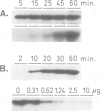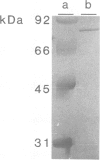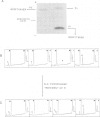Abstract
The Physarum EGTA-resistant actin-fragmin complex, previously named cap 42(a+b), is phosphorylated in the actin subunit by an endogenous kinase [Maruta and Isenberg (1983) J. Biol. Chem., 258, 10151-10158]. This kinase has been purified and characterized. It is an 80 kDa monomeric enzyme, unaffected by known kinase regulators. Staurosporine acts as a potent inhibitor. The actin-fragmin complex is the preferred substrate. The phosphorylation is inhibited by micromolar Ca2+ concentrations, but only in the presence of additional actin. Polymerized actin (vertebrate muscle and non-muscle isoforms) and actin complexes with various actin-binding proteins are poorly phosphorylated. The heterotrimer consisting of two actins and one fragmin, which is formed from cap 42(a+b) and actin in the presence of micromolar concentrations of Ca2+, is also a poor substrate. From the other substrates tested, only histones were significantly phosphorylated, in particular histone H1. In the same manner, casein kinase I could also phosphorylate the actin-fragmin complex. The major phosphorylation site in actin is Thr203. A second minor site is Thr202. These residues constitute one of the contact sites for DNase I [Kabsch et al. (1990) Nature, 347, 37-44] and are also part of one of the predicted actin-actin contact sites in the F-actin model [Holmes et al. (1990) Nature, 347, 44-49].
Full text
PDF
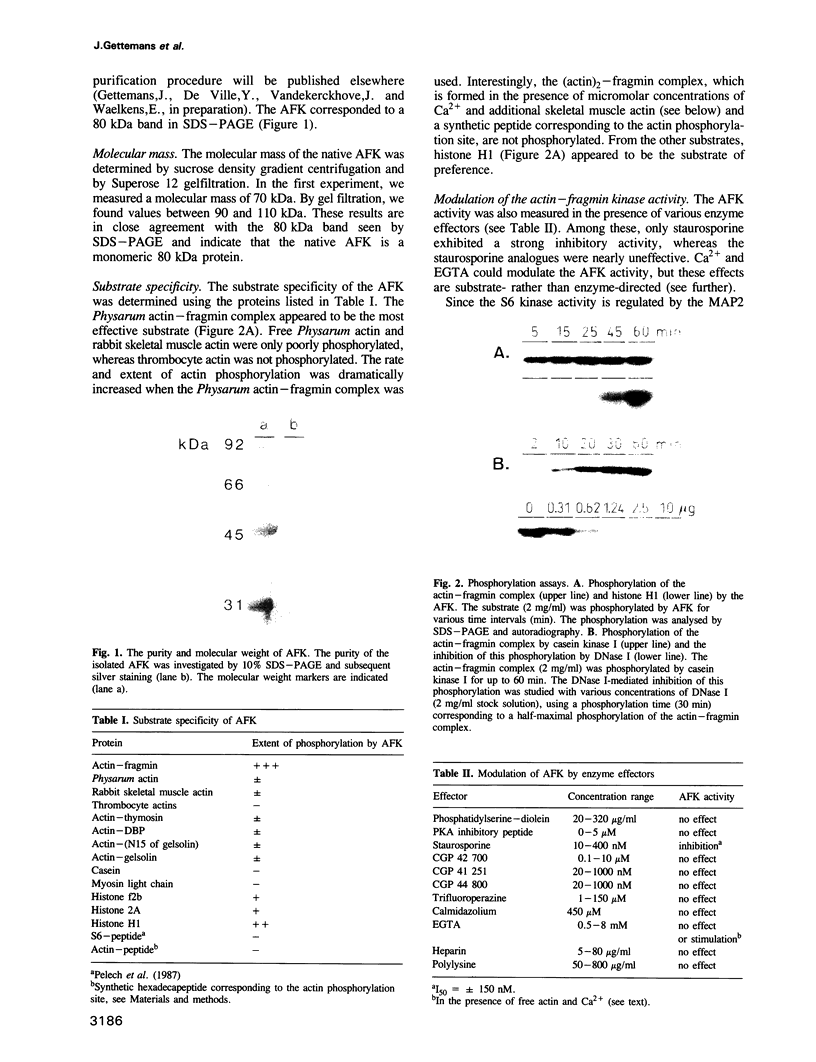
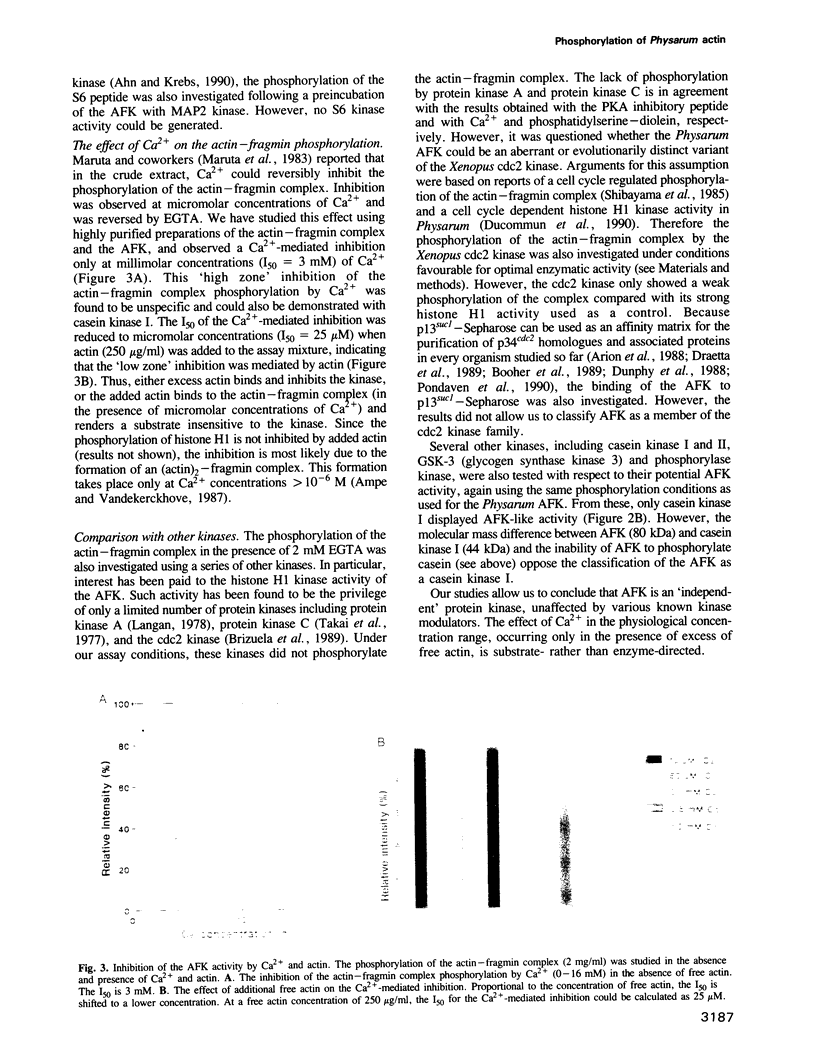
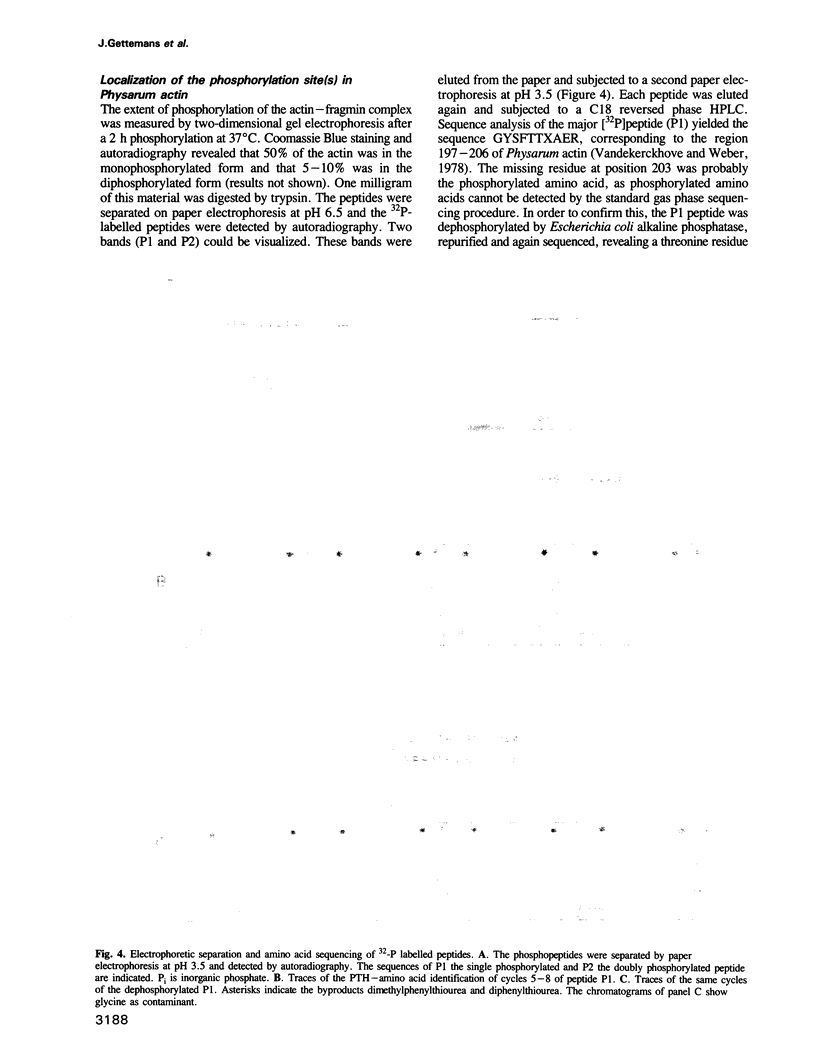
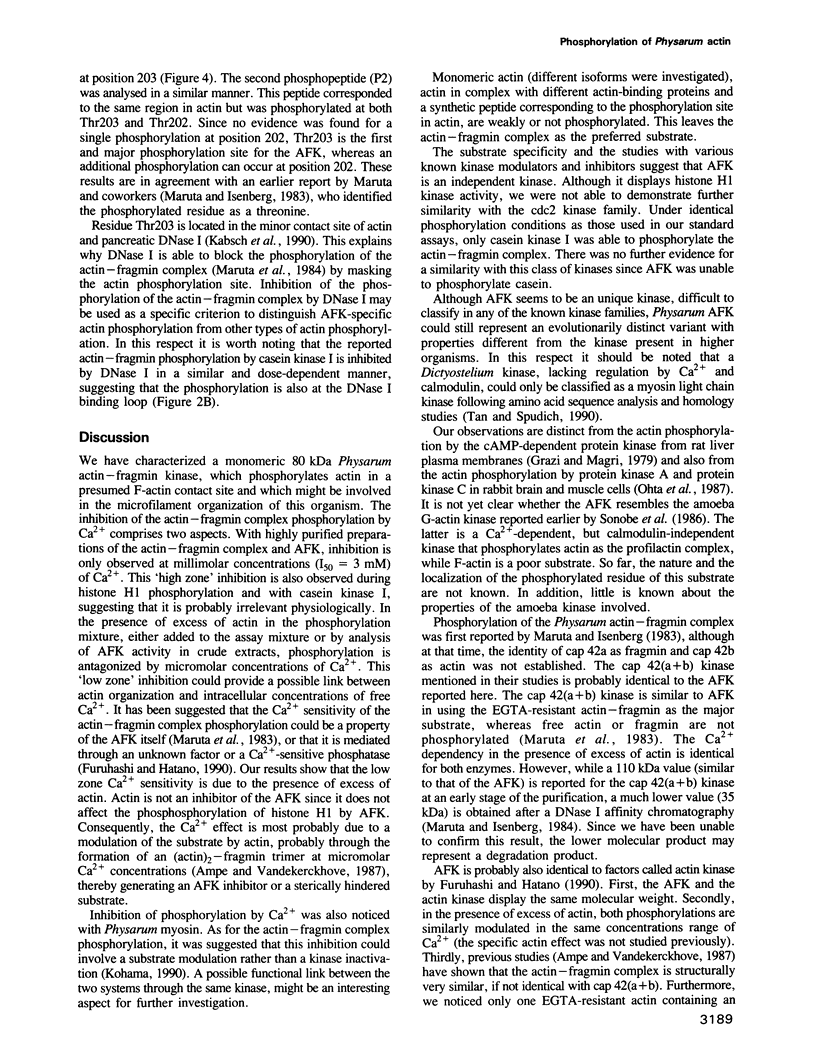
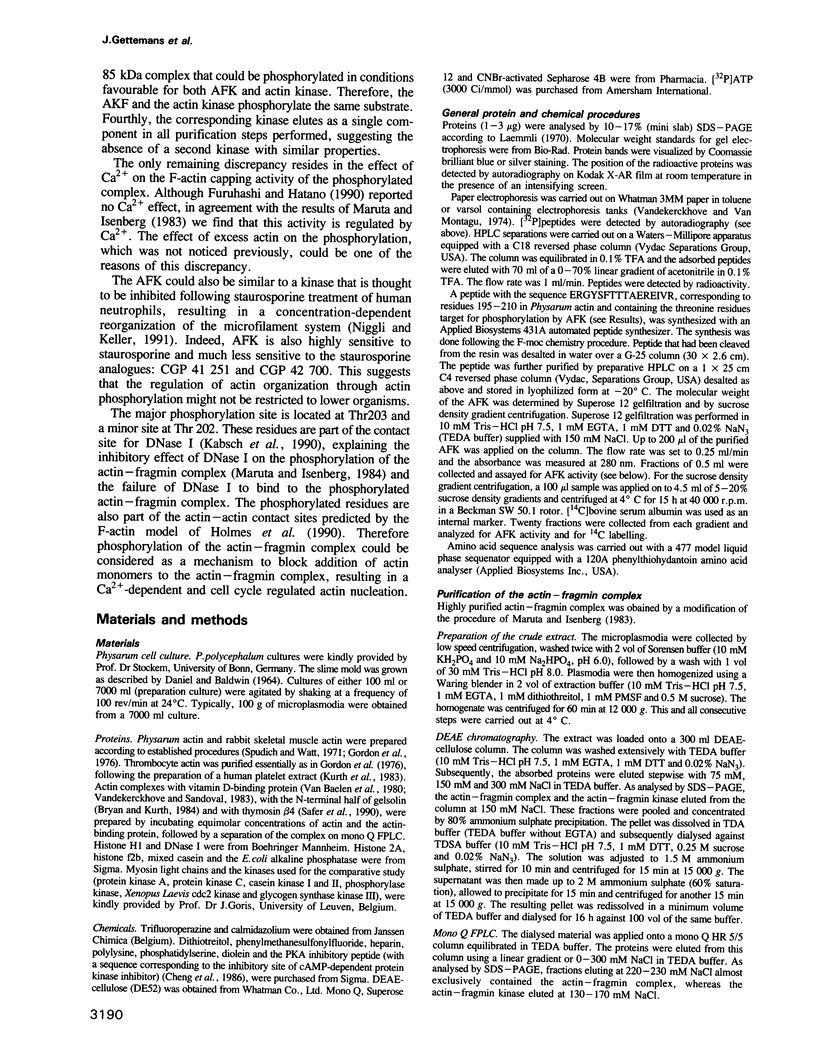
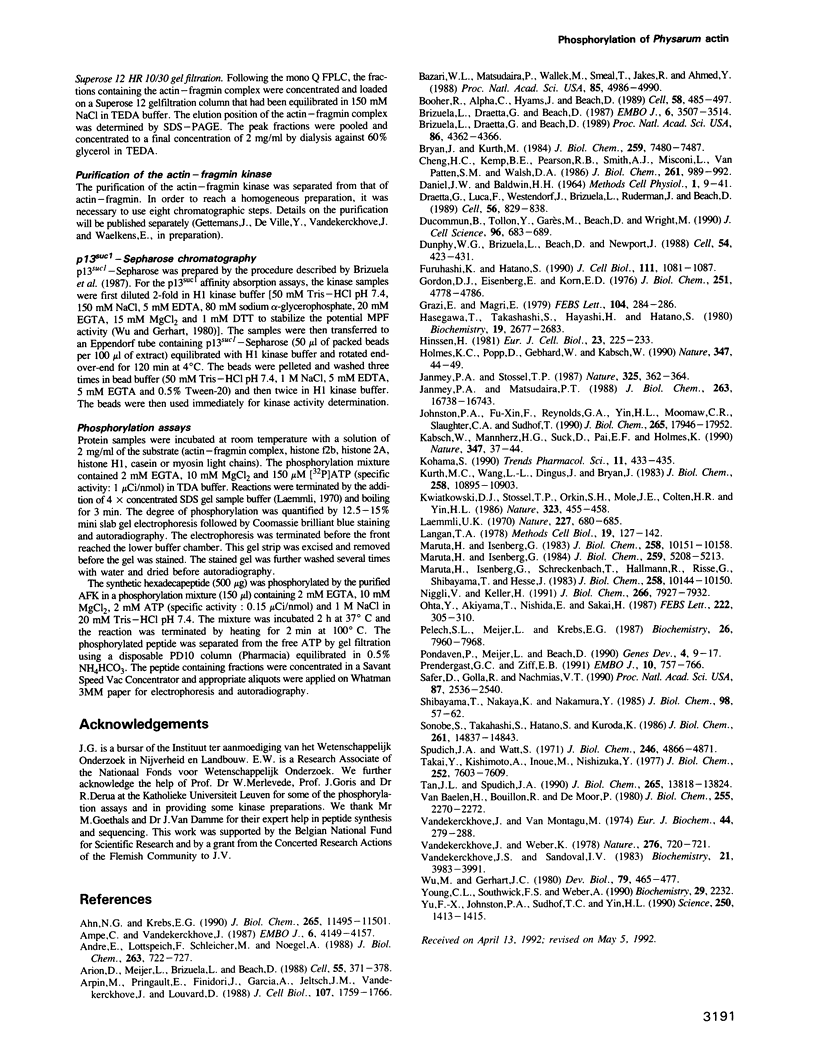
Images in this article
Selected References
These references are in PubMed. This may not be the complete list of references from this article.
- Ahn N. G., Krebs E. G. Evidence for an epidermal growth factor-stimulated protein kinase cascade in Swiss 3T3 cells. Activation of serine peptide kinase activity by myelin basic protein kinases in vitro. J Biol Chem. 1990 Jul 15;265(20):11495–11501. [PubMed] [Google Scholar]
- Ampe C., Vandekerckhove J. The F-actin capping proteins of Physarum polycephalum: cap42(a) is very similar, if not identical, to fragmin and is structurally and functionally very homologous to gelsolin; cap42(b) is Physarum actin. EMBO J. 1987 Dec 20;6(13):4149–4157. doi: 10.1002/j.1460-2075.1987.tb02761.x. [DOI] [PMC free article] [PubMed] [Google Scholar]
- André E., Lottspeich F., Schleicher M., Noegel A. Severin, gelsolin, and villin share a homologous sequence in regions presumed to contain F-actin severing domains. J Biol Chem. 1988 Jan 15;263(2):722–727. [PubMed] [Google Scholar]
- Arion D., Meijer L., Brizuela L., Beach D. cdc2 is a component of the M phase-specific histone H1 kinase: evidence for identity with MPF. Cell. 1988 Oct 21;55(2):371–378. doi: 10.1016/0092-8674(88)90060-8. [DOI] [PubMed] [Google Scholar]
- Arpin M., Pringault E., Finidori J., Garcia A., Jeltsch J. M., Vandekerckhove J., Louvard D. Sequence of human villin: a large duplicated domain homologous with other actin-severing proteins and a unique small carboxy-terminal domain related to villin specificity. J Cell Biol. 1988 Nov;107(5):1759–1766. doi: 10.1083/jcb.107.5.1759. [DOI] [PMC free article] [PubMed] [Google Scholar]
- Bazari W. L., Matsudaira P., Wallek M., Smeal T., Jakes R., Ahmed Y. Villin sequence and peptide map identify six homologous domains. Proc Natl Acad Sci U S A. 1988 Jul;85(14):4986–4990. doi: 10.1073/pnas.85.14.4986. [DOI] [PMC free article] [PubMed] [Google Scholar]
- Booher R. N., Alfa C. E., Hyams J. S., Beach D. H. The fission yeast cdc2/cdc13/suc1 protein kinase: regulation of catalytic activity and nuclear localization. Cell. 1989 Aug 11;58(3):485–497. doi: 10.1016/0092-8674(89)90429-7. [DOI] [PubMed] [Google Scholar]
- Brizuela L., Draetta G., Beach D. Activation of human CDC2 protein as a histone H1 kinase is associated with complex formation with the p62 subunit. Proc Natl Acad Sci U S A. 1989 Jun;86(12):4362–4366. doi: 10.1073/pnas.86.12.4362. [DOI] [PMC free article] [PubMed] [Google Scholar]
- Brizuela L., Draetta G., Beach D. p13suc1 acts in the fission yeast cell division cycle as a component of the p34cdc2 protein kinase. EMBO J. 1987 Nov;6(11):3507–3514. doi: 10.1002/j.1460-2075.1987.tb02676.x. [DOI] [PMC free article] [PubMed] [Google Scholar]
- Bryan J., Kurth M. C. Actin-gelsolin interactions. Evidence for two actin-binding sites. J Biol Chem. 1984 Jun 25;259(12):7480–7487. [PubMed] [Google Scholar]
- Cheng H. C., Kemp B. E., Pearson R. B., Smith A. J., Misconi L., Van Patten S. M., Walsh D. A. A potent synthetic peptide inhibitor of the cAMP-dependent protein kinase. J Biol Chem. 1986 Jan 25;261(3):989–992. [PubMed] [Google Scholar]
- Draetta G., Luca F., Westendorf J., Brizuela L., Ruderman J., Beach D. Cdc2 protein kinase is complexed with both cyclin A and B: evidence for proteolytic inactivation of MPF. Cell. 1989 Mar 10;56(5):829–838. doi: 10.1016/0092-8674(89)90687-9. [DOI] [PubMed] [Google Scholar]
- Ducommun B., Tollon Y., Garès M., Beach D., Wright M. Cell cycle regulation of p34cdc2 kinase activity in Physarum polycephalum. J Cell Sci. 1990 Aug;96(Pt 4):683–689. doi: 10.1242/jcs.96.4.683. [DOI] [PubMed] [Google Scholar]
- Dunphy W. G., Brizuela L., Beach D., Newport J. The Xenopus cdc2 protein is a component of MPF, a cytoplasmic regulator of mitosis. Cell. 1988 Jul 29;54(3):423–431. doi: 10.1016/0092-8674(88)90205-x. [DOI] [PubMed] [Google Scholar]
- Furuhashi K., Hatano S. Control of actin filament length by phosphorylation of fragmin-actin complex. J Cell Biol. 1990 Sep;111(3):1081–1087. doi: 10.1083/jcb.111.3.1081. [DOI] [PMC free article] [PubMed] [Google Scholar]
- Gordon D. J., Eisenberg E., Korn E. D. Characterization of cytoplasmic actin isolated from Acanthamoeba castellanii by a new method. J Biol Chem. 1976 Aug 10;251(15):4778–4786. [PubMed] [Google Scholar]
- Grazi E., Magri E. Phosphorylation of actin and removal of its inhibitory activity on pancreatic DNAase I by liver plasma membranes. FEBS Lett. 1979 Aug 15;104(2):284–286. doi: 10.1016/0014-5793(79)80833-9. [DOI] [PubMed] [Google Scholar]
- Hasegawa T., Takahashi S., Hayashi H., Hatano S. Fragmin: a calcium ion sensitive regulatory factor on the formation of actin filaments. Biochemistry. 1980 Jun 10;19(12):2677–2683. doi: 10.1021/bi00553a021. [DOI] [PubMed] [Google Scholar]
- Hinssen H. An actin-modulating protein from Physarum polycephalum. I. Isolation and purification. Eur J Cell Biol. 1981 Feb;23(2):225–233. [PubMed] [Google Scholar]
- Holmes K. C., Popp D., Gebhard W., Kabsch W. Atomic model of the actin filament. Nature. 1990 Sep 6;347(6288):44–49. doi: 10.1038/347044a0. [DOI] [PubMed] [Google Scholar]
- Janmey P. A., Matsudaira P. T. Functional comparison of villin and gelsolin. Effects of Ca2+, KCl, and polyphosphoinositides. J Biol Chem. 1988 Nov 15;263(32):16738–16743. [PubMed] [Google Scholar]
- Janmey P. A., Stossel T. P. Modulation of gelsolin function by phosphatidylinositol 4,5-bisphosphate. Nature. 1987 Jan 22;325(6102):362–364. doi: 10.1038/325362a0. [DOI] [PubMed] [Google Scholar]
- Johnston P. A., Yu F. X., Reynolds G. A., Yin H. L., Moomaw C. R., Slaughter C. A., Südhof T. C. Purification and expression of gCap39. An intracellular and secreted Ca2(+)-dependent actin-binding protein enriched in mononuclear phagocytes. J Biol Chem. 1990 Oct 15;265(29):17946–17952. [PubMed] [Google Scholar]
- Kabsch W., Mannherz H. G., Suck D., Pai E. F., Holmes K. C. Atomic structure of the actin:DNase I complex. Nature. 1990 Sep 6;347(6288):37–44. doi: 10.1038/347037a0. [DOI] [PubMed] [Google Scholar]
- Kohama K. Inhibitory mode for Ca2+ regulation. Trends Pharmacol Sci. 1990 Nov;11(11):433–435. doi: 10.1016/0165-6147(90)90121-n. [DOI] [PubMed] [Google Scholar]
- Kurth M. C., Wang L. L., Dingus J., Bryan J. Purification and characterization of a gelsolin-actin complex from human platelets. Evidence for Ca2+-insensitive functions. J Biol Chem. 1983 Sep 25;258(18):10895–10903. [PubMed] [Google Scholar]
- Kwiatkowski D. J., Stossel T. P., Orkin S. H., Mole J. E., Colten H. R., Yin H. L. Plasma and cytoplasmic gelsolins are encoded by a single gene and contain a duplicated actin-binding domain. Nature. 1986 Oct 2;323(6087):455–458. doi: 10.1038/323455a0. [DOI] [PubMed] [Google Scholar]
- Laemmli U. K. Cleavage of structural proteins during the assembly of the head of bacteriophage T4. Nature. 1970 Aug 15;227(5259):680–685. doi: 10.1038/227680a0. [DOI] [PubMed] [Google Scholar]
- Langan T. A. Methods for the assessment of site-specific histone phosphorylation. Methods Cell Biol. 1978;19:127–142. doi: 10.1016/s0091-679x(08)60018-7. [DOI] [PubMed] [Google Scholar]
- Maruta H., Isenberg G. Ca2+-dependent actin-binding phosphoprotein in Physarum polycephalum. II. Ca2+-dependent f-actin-capping activity of subunit a and its regulation by phosphorylation of subunit b. J Biol Chem. 1983 Aug 25;258(16):10151–10158. [PubMed] [Google Scholar]
- Maruta H., Isenberg G. Ca2+-dependent actin-binding phosphoprotein in Physarum polycephalum. Subunit b is a DNase I-binding and F-actin capping protein. J Biol Chem. 1984 Apr 25;259(8):5208–5213. [PubMed] [Google Scholar]
- Maruta H., Isenberg G., Schreckenbach T., Hallmann R., Risse G., Shibayama T., Hesse J. Ca2+-dependent actin-binding phosphoprotein in Physarum polycephalum. I. Ca2+/actin-dependent inhibition of its phosphorylation. J Biol Chem. 1983 Aug 25;258(16):10144–10150. [PubMed] [Google Scholar]
- Niggli V., Keller H. On the role of protein kinases in regulating neutrophil actin association with the cytoskeleton. J Biol Chem. 1991 Apr 25;266(12):7927–7932. [PubMed] [Google Scholar]
- Ohta Y., Akiyama T., Nishida E., Sakai H. Protein kinase C and cAMP-dependent protein kinase induce opposite effects on actin polymerizability. FEBS Lett. 1987 Oct 5;222(2):305–310. doi: 10.1016/0014-5793(87)80391-5. [DOI] [PubMed] [Google Scholar]
- Pelech S. L., Meijer L., Krebs E. G. Characterization of maturation-activated histone H1 and ribosomal S6 kinases in sea star oocytes. Biochemistry. 1987 Dec 1;26(24):7960–7968. doi: 10.1021/bi00398a062. [DOI] [PubMed] [Google Scholar]
- Pondaven P., Meijer L., Beach D. Activation of M-phase-specific histone H1 kinase by modification of the phosphorylation of its p34cdc2 and cyclin components. Genes Dev. 1990 Jan;4(1):9–17. doi: 10.1101/gad.4.1.9. [DOI] [PubMed] [Google Scholar]
- Prendergast G. C., Ziff E. B. Mbh 1: a novel gelsolin/severin-related protein which binds actin in vitro and exhibits nuclear localization in vivo. EMBO J. 1991 Apr;10(4):757–766. doi: 10.1002/j.1460-2075.1991.tb08007.x. [DOI] [PMC free article] [PubMed] [Google Scholar]
- Safer D., Golla R., Nachmias V. T. Isolation of a 5-kilodalton actin-sequestering peptide from human blood platelets. Proc Natl Acad Sci U S A. 1990 Apr;87(7):2536–2540. doi: 10.1073/pnas.87.7.2536. [DOI] [PMC free article] [PubMed] [Google Scholar]
- Shibayama T., Nakaya K., Nakamura Y. Changes in phosphorylation of an F-actin capping protein of Physarum polycephalum during the cell cycle. J Biochem. 1985 Jul;98(1):57–62. doi: 10.1093/oxfordjournals.jbchem.a135272. [DOI] [PubMed] [Google Scholar]
- Sonobe S., Takahashi S., Hatano S., Kuroda K. Phosphorylation of Amoeba G-actin and its effect on actin polymerization. J Biol Chem. 1986 Nov 5;261(31):14837–14843. [PubMed] [Google Scholar]
- Spudich J. A., Watt S. The regulation of rabbit skeletal muscle contraction. I. Biochemical studies of the interaction of the tropomyosin-troponin complex with actin and the proteolytic fragments of myosin. J Biol Chem. 1971 Aug 10;246(15):4866–4871. [PubMed] [Google Scholar]
- Takai Y., Kishimoto A., Inoue M., Nishizuka Y. Studies on a cyclic nucleotide-independent protein kinase and its proenzyme in mammalian tissues. I. Purification and characterization of an active enzyme from bovine cerebellum. J Biol Chem. 1977 Nov 10;252(21):7603–7609. [PubMed] [Google Scholar]
- Tan J. L., Spudich J. A. Dictyostelium myosin light chain kinase. Purification and characterization. J Biol Chem. 1990 Aug 15;265(23):13818–13824. [PubMed] [Google Scholar]
- Van Baelen H., Bouillon R., De Moor P. Vitamin D-binding protein (Gc-globulin) binds actin. J Biol Chem. 1980 Mar 25;255(6):2270–2272. [PubMed] [Google Scholar]
- Vandekerckhove J. S., Sandoval I. V. Purification and characterization of a new mammalian serum protein with the ability to inhibit actin polymerization and promote depolymerization of actin filaments. Biochemistry. 1982 Aug 17;21(17):3983–3991. doi: 10.1021/bi00260a013. [DOI] [PubMed] [Google Scholar]
- Vandekerckhove J., Van Montagu M. Sequence analysis of fluorescamine-stained peptides and proteins purified on a nanomole scale. Application to proteins of bacteriophage MS2. Eur J Biochem. 1974 May 2;44(1):279–288. doi: 10.1111/j.1432-1033.1974.tb03483.x. [DOI] [PubMed] [Google Scholar]
- Vandekerckhove J., Weber K. The amino acid sequence of Physarum actin. Nature. 1978 Dec 14;276(5689):720–721. doi: 10.1038/276720a0. [DOI] [PubMed] [Google Scholar]
- Wu M., Gerhart J. C. Partial purification and characterization of the maturation-promoting factor from eggs of Xenopus laevis. Dev Biol. 1980 Oct;79(2):465–477. doi: 10.1016/0012-1606(80)90131-1. [DOI] [PubMed] [Google Scholar]
- Young C. L., Southwick F. S., Weber A. Kinetics of the interaction of a 41-kilodalton macrophage capping protein with actin: promotion of nucleation during prolongation of the lag period. Biochemistry. 1990 Mar 6;29(9):2232–2240. doi: 10.1021/bi00461a005. [DOI] [PubMed] [Google Scholar]
- Yu F. X., Johnston P. A., Südhof T. C., Yin H. L. gCap39, a calcium ion- and polyphosphoinositide-regulated actin capping protein. Science. 1990 Dec 7;250(4986):1413–1415. doi: 10.1126/science.2255912. [DOI] [PubMed] [Google Scholar]



